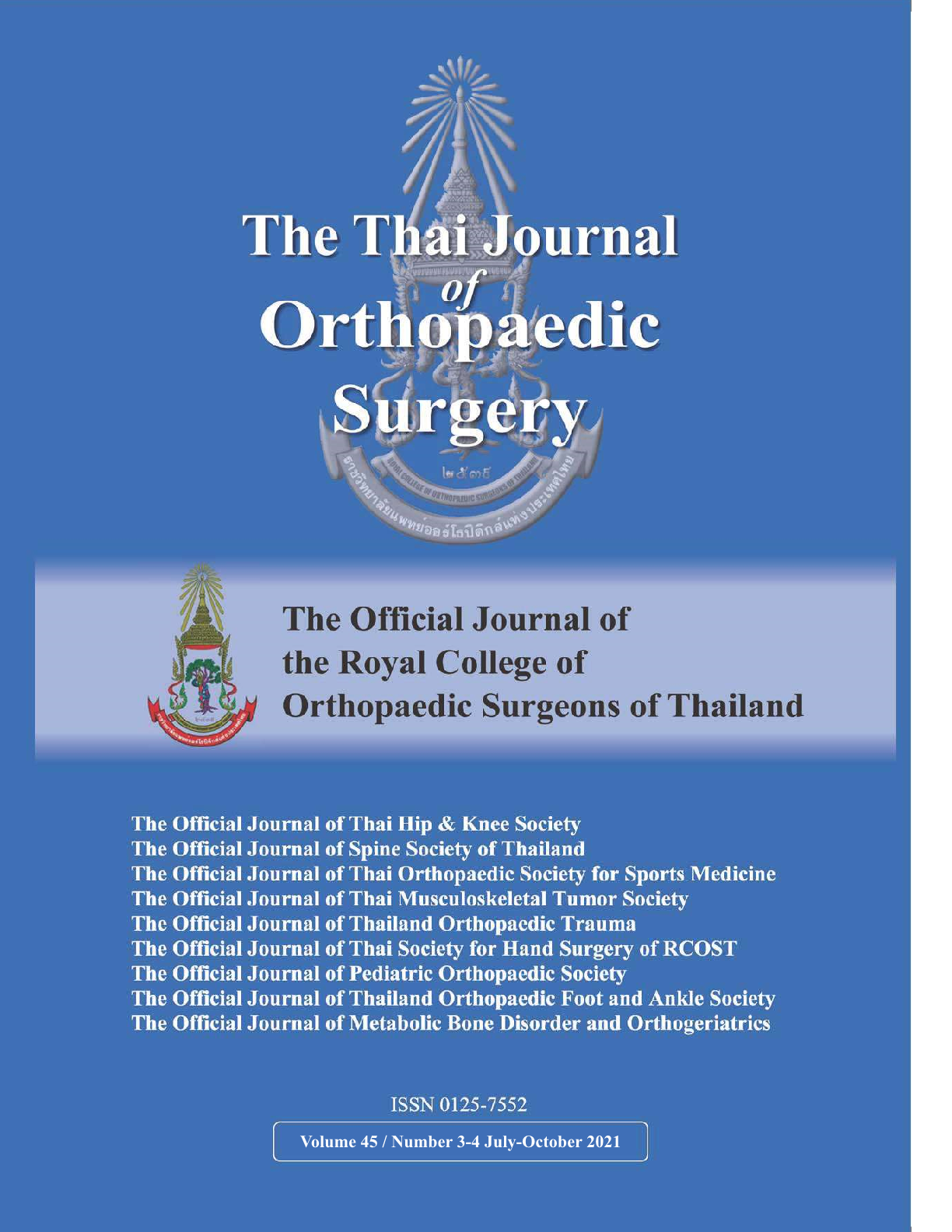Comparison of Non-continuous Versus Continuous Drain Use Following Thoracolumbar Spine Surgery
Main Article Content
Abstract
Purpose: To evaluate the efficacy and safety of non-continuous drain use following posterior instrumented fusion in thoracolumbar spinal injury.
Methods: Retrospective identification of patients with thoracolumbar spinal injury operated posterior instrumented fusion during the period 2013-2016 into 2 groups. Group I (non-continuous drain use): received 2-hour temporary drain clamping and group II (continuous drain use): no clamping. The groups were evaluated the amount of drain content in 8th, 16th, 24th, 48th, and 72nd hour. The entire period of drain use, the hemoglobin level change, post-operative Packed Red Cell (PRC) transfusion, Visual Analogue Scale (VAS), and wound complications between two groups were also compared.
Results: A total of 56 patients were included; their age was 51.50 years and 36 years on average in non-continuous drain group and continuous drain group retrospectively. 53.6% and 75% were male in non-continuous drain group and continuous drain group retrospectively. The drain content in 8-hour postoperative period and hemoglobin level change were significantly lower in the non-continuous drain group than the continuous group whereas the post-operative PRC transfusion, VAS, hospital length stay, total drain content, total drain use time and wound complications were not different between two groups.
Conclusion: The use of non-continuous drain following posterior instrumented fusion in thoracolumbar spinal injury can reduce patients’ post-operative hemoglobin level difference. However, there was no statistically significant difference in term of postoperative blood transfusion, VAS, total drain content, entire period of drain use, the length of hospital stay as well as wound complications.
Article Details
References
2. Awad JN, Kebaish KM, Donigan J, Cohen DB, Kostuik JP. Analysis of the risk factors for the development of post-operative spinal epidural haematoma. J Bone Joint Surg Br. 2005; 87(9): 1248-52.
3. Li T, Zhuang Q, Weng X, Zhou L, Bian Y. Non-continuous versus continuous wound drainage after total knee arthroplasty: a meta-analysis. Int Orthop. 2014; 38(2): 361-71.
4. Kou J, Fischgrund J, Biddinger A, Herkowitz H. Risk factors for spinal epidural hematoma after spinal surgery. Spine (Phila Pa 1976). 2002; 27(15): 1670-3.
5. Scuderi GJ, Brusovanik GV, Fitzhenry LN, Vaccaro AR. Is wound drainage necessary after lumbar spinal fusion surgery? Med Sci Monit. 2005; 11(2): 64-6.
6. von Eckardstein KL, Dohmes JE, Rohde V. Use of closed suction devices and other drains in spinal surgery: results of an online, Germany-wide questionnaire. Eur Spine J. 2016; 25(3): 708‐15.
7. Wang H, Zhang Y, Xiang Q, Wang X, Li C, Xiong H, et al. Epidemiology of traumatic spinal fractures: Experience from medical university-affiliated hospitals in Chongqing, China, 2001-2010. J Neurosurg Spine. 2012; 17(5): 459-68.
8. Joaquim AF, Patel AA. Thoracolumbar spine trauma: Evaluation and surgical decision-making. J Craniovertebr Junction Spine. 2013; 4(1): 3-9.
9. Waly F, Alzahrani MM, Abduljabbar FH, Landry T, Ouellet J, Moran K, et al. The outcome of using closed suction wound drains in patients undergoing lumbar spine surgery: a systematic review. Global Spine J. 2015; 5(6): 479-85.
10. Elizalde JI, Clemente J, Marín JL, Panés J, Aragón B, Mas A, Piqué JM, Terés J. Early changes in hemoglobin and hematocrit levels after packed red cell transfusion in patients with acute anemia. Transfusion. 1997; 37(6): 573-6.
11. Andrew Glennie R, Dea N, Street JT. Dressings and drains in posterior spine surgery and their effect on wound complications. J Clin Neurosci. 2015; 22(7): 1081‐7.
12. Schroeder GD, Kurd MF, Kepler CK, Arnold PM, Vaccaro AR. Postoperative Epidural Hematomas in the Lumbar Spine. J Spinal Disord Tech. 2015; 28(9): 313-8.
13. Brown MD, Brookfield KF. A randomized study of closed wound suction drainage for extensive lumbar spine surgery. Spine (Phila Pa 1976). 2004; 29(10): 1066-8.
14. Kanayama M, Oha F, Togawa D, Shigenobu K, Hashimoto T. Is closed-suction drainage necessary for single-level lumbar decompression?: review of 560 cases. Clin Orthop Relat Res. 2010; 468(10): 2690‐4.
15. Pennington Z, Lubelski D, Molina C, Westbroek EM, Ahmed AK, Sciubba DM. Prolonged post-surgical drain retention increases risk for deep wound infection after spine surgery. World Neurosurg. 2019; 130: e846‐e853.
16. Li Z, Liu P, Zhang C, Xu G, Zhang Y, Chang Y, et al. Incidence, prevalence, and analysis of risk factors for surgical site infection after lumbar fusion surgery: ≥2-year follow-up retrospective study. World Neurosurg. 2019; 131: e460‐e467.
17. Poorman CE, Passias PG, Bianco KM, Boniello A, Yang S, Gerling MC. Effectiveness of postoperative wound drains in one- and two-level cervical spine fusions. Int J Spine Surg. 2014; 8: 34


